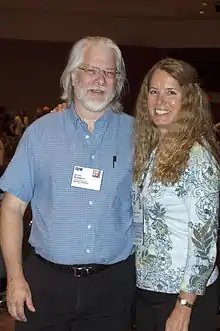Michael Gribskov
Michael Gribskov is a professor of Biological Sciences and Computer Science at Purdue University. In 1979, Gribskov graduated from Oregon State University, with a Bachelor in Science Honors degree in Biochemistry and Biophysics. Later in 1985, he finished his PhD degree in Molecular Biology from University of Wisconsin–Madison.[1]

He has served as President of the International Society for Computational Biology,[2] and his faculty page states that he is the chair of the Protein Information Resource Scientific Oversight and Advisory Board, and on the editorial boards of the journals Bioinformatics, Journal of Computational Biology and Chemistry, and Journal of Molecular Microbiology & Biotechnology.[1]
| Year | Position |
|---|---|
| 1979 | B.S. with Honors in Biochemistry and Biophysics Oregon State University |
| 1979–1984 | NIH predoctoral training grant University of Wisconsin-Madison |
| 1985 | Ph.D. in Molecular Biology University of Wisconsin-Madison |
| 1985–1987 | American Cancer Society post-doctoral fellowship University of California - Los Angeles |
| 1988–1992 | Scientist Associate National Cancer Institute—FCRDC |
| 1992 | Staff Scientist San Diego Supercomputer Center |
| 1993–1996 | Senior Staff Scientist San Diego Supercomputer Center |
| 1993–1999 | Adjunct Assistant Professor of Biology University of California, San Diego |
| 1994–1997 | Principal Investigator Structural Queries on Nucleic Acid Databases |
| 1999–2003 | Adjunct Associate Professor of Biology University of California, San Diego |
| 2004–present | Professor of Biological Science and Computer Science Purdue University |
Profile analysis
Gribskov, along with David Eisenberg and Andrew McLachlan, introduced the profile analysis method in 1987; this is a method for detecting distantly related proteins by sequence comparison. A profile is a position specific scoring matrix, and it is created from a group of sequences previously aligned (probe). The similarity of any other sequence (target) (one or more than one) to the probe can be tested by comparing the target to the file using dynamic programming. This algorithm consists of two steps. The first step is the generation of the profile using software PROFWARE, which makes use of an existing alignment (probe) based on sequence similarity or the corresponding 3D structure to generate a profile. The second step is the comparison of the profile with a database of sequences or a single sequence. In this step, based on the profile generated, the target sequence or group of sequences could be aligned using PROFINAL, dynamic programming is used in the alignment.[3]
References
- Purdue University Faculty Profile Archived 2011-12-03 at the Wayback Machine
- History of ISCB
- Gribskov, M; McLachlan, AD; Eisenberg, D (July 1987). "Profile analysis: detection of distantly related proteins". Proceedings of the National Academy of Sciences of the United States of America. 84 (13): 4355–8. doi:10.1073/pnas.84.13.4355. PMC 305087. PMID 3474607.
| Preceded by Philip Bourne |
President of the International Society for Computational Biology 2003 – 2007 |
Succeeded by Burkhard Rost |